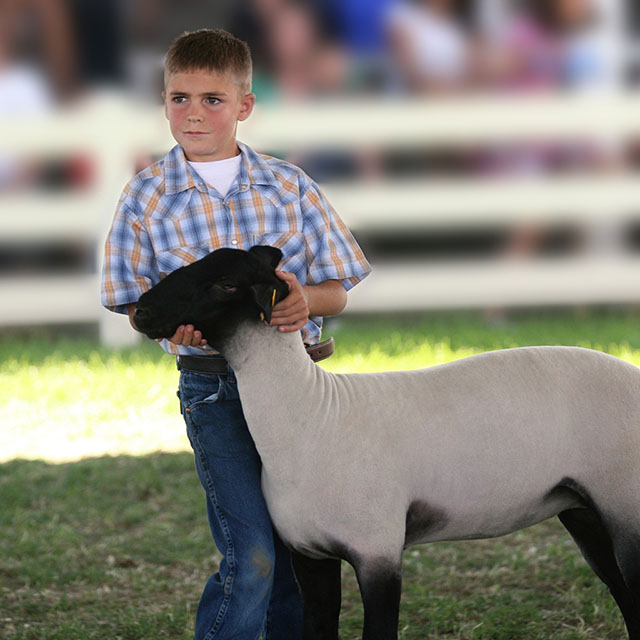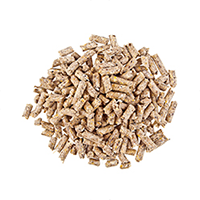Show Animal Management
Showing animals can teach children responsibility and hard work. The Equity supports 4-H and FFA across our trade area. The Equity Farm & Home Store is here to help support all projects, from livestock to electricity, tractor safety, woodworking, and more.

Swine
The first basic needs of show animals are the same as non-show animals. Fresh water, fresh feed in a feed pan at the appropriate height, proper ventilation, and clean bedding and pens. With swine projects, a larger chip will avoid getting dust in ear. For younger pigs a heat lamp may be needed depending on the temperature and environment in which they are housed. Since the purpose of these animals is show, make sure to keep them clean, their skin soft and moist, and don not let them get dry.
Around two weeks of age, put piglets on pre-starter then transition them to a 20% protein starter for several weeks for muscle and growth. Next, move to a lower 18% protein feed source to slow growth and start adding fat. Finally, switch them over to a 15% protein to finish them out and acquire a soft finish. You can switch back and forth between feeds to change fat cover and muscle composition as need it. Also, additives can be added to a ration to add belly, muscle, clean up fronts, and help with structure.
Remember to vaccinate for respiratory disease, deworm, and get ID tags put in. If you are showing a purebred, you will need to get registration papers.
Start to introduce a moving tool to them as soon as possible. Some people prefer a whip or rubber pipe but there are a few options. The tool should be used by tapping the animal to direct them which way they should move. Start walking, sometimes referred to as driving, them after they are familiar to the moving tool. Initially practice this in a small area first, such as a walkway in a barn, then move to larger area outside. Shorter time intervals are recommended at first then work your way up to 30 minutes or more keeping their head up while driving. This will allow the judge to view their profile while sorting the class and if practiced will come natural to the animal in the show ring.
An education video on selection, feeding and care can be found at the below link through Show Rite.
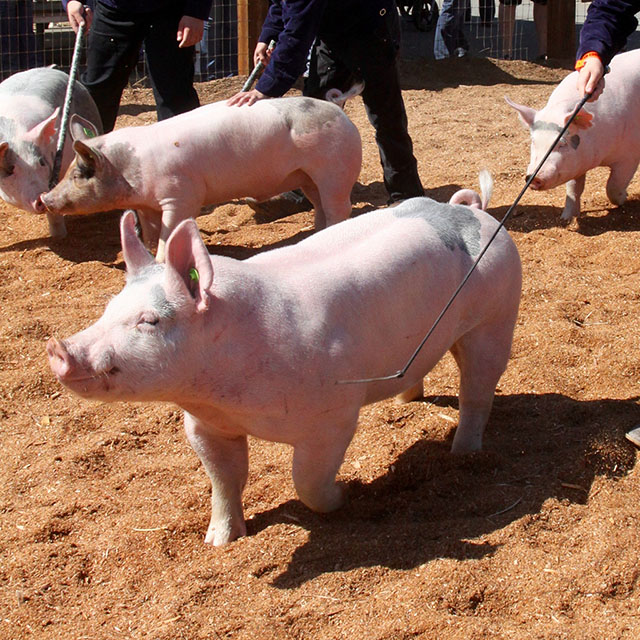
Cattle
The first basic needs of show animals are the same as non-show animals. Fresh water, fresh feed at the appropriate height, proper ventilation, and clean bedding and pens. With beef projects, corn stocks or straw work great outside. In a pen, lean-to, barn or stalling area, utilizing bark, wood shavings, or cedar fibers will keep the animals cleaner and promote healthy skin and hair growth.
Hair and hide are vital for beef projects. Be sure to keep them dandruff free and their hair and hide clean and in good condition. Working hair daily promotes growth and trains the hair to stand up or lay where you want so it enhances the look of the animal. Some people utilize a cooler to keep their beef projects cooler and promote hair growth, but it is not necessary if you have hard work and dedication to working your projects hair.
Along with hide and hair, hoof care if important for beef show stock. Make sure you are monitoring the hoof length and structure. Any that are long, or the animal is wearing down that would cause them to walk tenderly or lameness are a concern. Have someone else lead your animal and watch hoof placement, weight bearing and if the pasterns are locking. A hoof trimmer can come out to your farm to work on length or wearing that may occur on some spots. If it is past that, you may need to contact a veterinarian.
Around three weeks of age, introduce a high fiber creep feed to enhance ruminant development and growth. Just before or right after weaning, move them to 14% developer ration for several months through sale season. Then switch them to a finishing ration to add condition and hair. When it starts warming up, revert back to a grower ration to cruise them along during the summer months, keeping them cooler and help hair growth. Also, always allow free choice grass hay.
The ration may need to change based on the body condition of each animal. Each calf will feed just a bit differently. Additives can be added to add belly, muscle, clean up fronts, and help with structure.
Remember to vaccinate for respiratory disease, deworm, and get ID tags put in. If you are showing a purebred, you will need to get registration papers.
Start by breaking your animal to a halter then to lead as soon as you get them home. Then progress into showmanship with your animal. Getting them familiar to the show halter and show stick will help greatly in the ring. The faster your animal sets up the more the judge has an opportunity to assess them, so breaking them to either walk into a profile position or breaking them to a stick is imperative. Make sure they are exposed to people being close to, walking around, and handling them because a judge will typically do those things in the ring, especially in a steer class.
An education video on selection, feeding and care can be found at the below link through Show Rite.
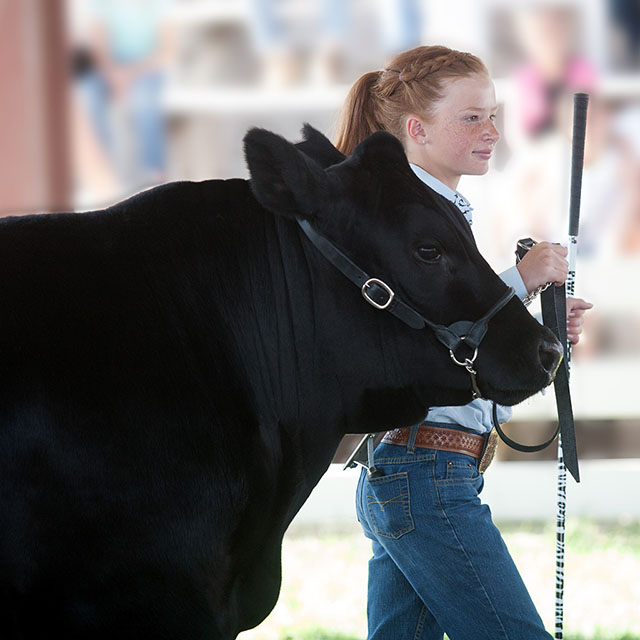
Goats
The first basic needs of show animals are the same as non-show animals. Fresh water, fresh feed, proper ventilation, and clean bedding and pens. With goat projects, straw, wood chips, or shavings work best to keep the animals cleaner and promote healthy skin and hair growth.
Hair and hide are important, so be sure to keep the hair and hide clean and both in good condition. Working hair daily promotes growth and trains the hair to stand up or lay where you want so it enhances the look of the animal.
Along with hide and hair, hooves should be monitored for length and structure. Any that are long, or the animal is wearing down that would cause them to walk tenderly or lameness are a concern. Have someone else lead your animal and watch hoof placement and weight bearing.
Around one to two months of age, put kids on an 18% starter pellet until two to four months when they should be switched to an 18% grower ration or as needed based on your animal’s growth pattern. Keep does and buck on a 18% until ready to freshen up or add showring flesh. For finishing, switch to a 16% ration to get added flesh or to reach wanted market weight. Feeding will change based on body condition, each kid will feed just a bit differently. Feed grass or alfalfa hay as needed and limit feed. Additives can be added to add belly, muscle, clean up fronts, and help with structure.
Start by breaking your animal to a halter as soon as you get them home. Then progress into showmanship with your animal. Getting them familiar to being led with a lead and being set up will help greatly in the ring. The faster your animal sets up the more the judge has an opportunity to assess them. Make sure they are exposed to people being close to, walking around, and handling them because a judge will typically do those things in the ring.
Exercise every day is vital to build muscle and keep goats from getting wasty. Also, teaching your animal to brace and practicing this daily will set you apart in the show ring.
Remember to vaccinate for respiratory disease, deworm, and get ID tags put in. If you are showing a purebred, you will need to get registration papers.
An education video on selection, feeding and care can be found at the below link through Show Rite.
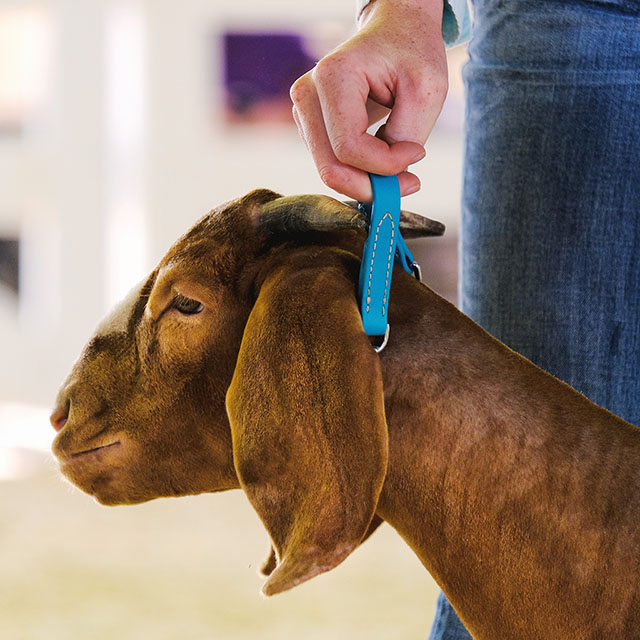
Sheep
The first basic needs of show animals are the same as non-show animals. Fresh water, fresh feed, proper ventilation, and clean bedding and pens. With sheep projects, straw, wood chips, or shavings work best to keep the animals cleaner and promote healthy skin and hair growth. For younger lambs, a heat lamp may be needed depending on the temperature and environment in which they are housed.
Wool and hide are important, so be sure to keep the wool and hide clean and both in good condition. Working wool daily promotes growth. Also, keep legs wrapped or lamb muzzled to keep them from chewing their leg wool off.
Along with hide and hair, hooves should be monitored for length and structure. Any that are long, or the animal is wearing down that would cause them to walk tenderly or lameness are a concern. Have someone else lead your animal and watch hoof placement and weight bearing.
Around one to two months of age, put lambs on a 20% starter pellet until two months when they should be switched to a 15% protein ration until finished or desired weight is reached. Feeding will change based on body condition, each lamb will feed just a bit differently. Ensure you maintain a firm handle. Feed grass or alfalfa hay as needed. Additives can be added to maintain condition and body. As well as add muscle, clean up fronts, and help with structure.
Start by breaking your animal to a halter as soon as you get them home. Then progress into showmanship with your animal. Getting them familiar to being led with a lead and being set up will help greatly in the ring. The faster your animal sets up the more the judge has an opportunity to assess them. Make sure they are exposed to people being close to, walking around, and handling them because a judge will typically do those things in the ring.
Exercise every day is vital to build muscle and keep your lamb firm. Also, teaching your animal to brace and practicing this daily will set you apart in the show ring.
Remember to vaccinate for respiratory disease, deworm, and get ID tags put in. If you are showing a purebred, you will need to get registration papers.
An education video on selection, feeding and care can be found at the below link through Show Rite.
